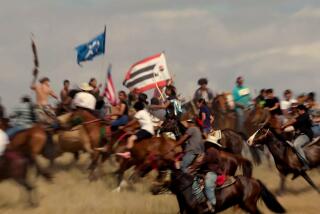Determined Shape of Nation : Century Fails to Heal Wounds Caused by Canadian Uprising
- Share via
BATOCHE, Canada — This is a sad and lonely place. The steeple of a simple prairie church and a tiny cemetery are the only reminders of a bleak day a century ago when a proud people was crushed by the advance of modern society.
The people were metis, the French-speaking descendants of explorers and North American Indians. Because of their ability to live on the harsh Canadian plains, they were known to neighboring Indians as “Lords of the Land.”
From the bluff overlooking the South Saskatchewan River, one can just make out the earthworks where, on May 12, 1885, fewer than 300 metis, their ammunition exhausted after four days of assault, were finally overrun by Canadian troops three times their number.
The village, which never counted more than 500 inhabitants, is gone, although there is still a road sign on the little-used highway that leads almost nowhere.
What can be seen clearly is the large, hand-hewn wooden cross that marks the burial ground for the metis, who died in a last desperate effort to determine their place in a society they helped to build.
Superficially, the Battle of Batoche signifies little. Only 25 men were killed, and there is little awareness in the country that it was a pivotal event in Canadian history.
The battle, though, opened the way for settlement by English-speaking outsiders from the east and determined the shape of the new nation of Canada, enabling the central government in Ottawa to impose its rule from Nova Scotia to Victoria Island, 5,000 miles to the west.
And if time has erased all but symbolic remembrances and burial markers bearing metis’ names--Caron, Parenteau, Dumont, St. Germain--it has not resolved the grievances that led to the rebellion, nor has it healed the wounds left by the war.
The federal government is building a small museum here, and it has renovated the Church of St. Antoine-de-Padoue as part of a modest centenary celebration, but there is no plan to re-enact the battle.
“Feelings are still strong,” said Louis Guyot, director of the Batoche National Historical Site. “There could be no re-enactment because the people are still too emotional.”
These feelings extend well beyond the 150 metis families that still live and farm in this vast land; they reach into the minds and souls of the French-Canadians of Quebec, where the destruction of the metis’ dreams of nationhood is still viewed as the repression of French culture in North America.
The distrust, even bitterness, is not reserved for the metis’ descendants and Canada’s French-speakers. Serious political and academic figures in the English sections of Canada still view the metis of 1885--and particularly their two most important leaders, Louis Riel and Gabriel Dumont--as, at best, outdated obstacles to progress, at worst, traitors.
The acrid memories held by the French Canadians have deeply influenced national politics. The Conservative Party (now the Progressive Conservative Party) held power in 1885, and was all but abandoned by French Canadians until last year, when it won a majority in Parliament for only the second time in 100 years.
This lingering suspicion and suppressed anger accounts for the low-key government attitude toward the Battle of Batoche, as well as a confused approach to the memory of Riel. It is as if Robert E. Lee had been considered so unspeakable as to be unfit for any appreciation during the centenary celebration of the U.S. Civil War.
Riel, a complicated but magnetic metis leader, is one of the most controversial figures in Canadian history. He led the Red River Uprising in 1870, which established Manitoba as a province.
Considered by most historians as a mystic, an erratic but basically nonviolent conciliator, Riel was asked by the Saskatchewan metis community to help them negotiate with the officials of the newly formed Canadian confederation to ensure their way of life and political rights in what was then known as the Northwest Territories.
Riel, who had moved to Montana and had become an American citizen after his Manitoba agreements were broken by the English-dominated legislature, agreed and went to Batoche in 1884.
Hanged for Treason
After the metis were defeated, Riel surrendered. He was tried for treason by an English-speaking jury in Regina and hanged, an act that is still resented by French-Canadians.
Whether the execution of Riel was justified, indeed whether the metis grievances were valid, continue to be serious questions for many historians. The dispute is flaring again with publication of a book that argues that the federal government in Ottawa provoked the uprising.
Donald McLean of the Gabriel Dumont Institute in Regina says he has uncovered proof that Canada’s first prime minister, Sir John A. Macdonald, sent an agent provocateur to Saskatchewan “to do as much as possible to get the metis to fight.”
Macdonald, according to McLean, calculated that the metis would be defeated, but would so frighten the members of Parliament that they would approve $25 million to complete a transnational railroad across the plains.
This means, McLean says, that Riel was wrongly hanged and that his conviction should be overturned. Even a pardon is insufficient, according to Leslie Benjamin, a member of Parliament from Regina, because it would suggest that Riel was in fact guilty.
‘Surprisingly Fair Trial’
The traditional English view of Riel and the metis rebellion is repeated in a recent book, “Riel and the Rebellion, 1885 Reconsidered.” In it, a University of Calgary political scientist, Thomas Flanagan, argues that the metis’ grievances were “at least partly of their own making, that the Macdonald government was on the verge of resolving them . . . and that (Riel) received a surprisingly fair trial.”
Even the question of Riel as a person remains in dispute. Flanagan calls him “a humorless, single-minded ideologue.” Yet George Woodcock, one of Canada’s most respected historians and writers, describes him as a charismatic figure who elicited love and devotion from his followers and who, though a failure as a military leader, was opposed to unnecessary bloodshed and turned to rebellion only when the government left him no option.
Whatever the view, history shows that the metis were deprived of what had been a unique and, for the time, modern society. Their life was not identical to that of the Plains Indians, but they shared many values concerning the use of the land.
Increasingly as the herds of buffalo were destroyed, the metis turned from hunting and trapping to farming and transporting goods.
Disputes Over Land
The main disputes came over land ownership. The metis had arrived in the territory well before the Canadian officials sent in survey teams, and they had defined plots of land that did not conform to the systems used by the surveyors.
As a result, the Ottawa government refused to recognize metis ownership. Furthermore, the Canadians refused to give the Metis proper representation in the territorial government and rejected requests for the issuance of currency necessary to buy land even under the Ottawa survey.
As a result, the Metis were robbed of their land and disenfranchised.
As Woodcock puts it, the metis “asked only to be able to make their own adaptations, in their own way, to the changing patterns of history; that opportunity was not allowed them.”
The effects of the Battle of Batoche still ripple through Canadian society and continue to roil political life. The remnants of the metis are still largely without a voice. They are not recognized or given the special legal status extended to Canadian Indians, nor do they have the right to reservations of land, as do the Indians.
Metis efforts to establish some rights in negotiations to form new provinces have met with failure.
In effect, 100 years after the metis were overwhelmed by larger numbers and better guns, they are still a people outside the mainstream of the nation they helped create.
More to Read
Sign up for Essential California
The most important California stories and recommendations in your inbox every morning.
You may occasionally receive promotional content from the Los Angeles Times.













